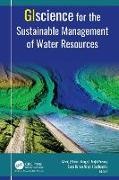Condividi
Fr. 226.00
Majid Farooq, Shruti Kanga, Gowhar Meraj, Suraj Kumar Singh, Sudhanshu
GIScience for the Sustainable Management of Water Resources
Inglese · Copertina rigida
Spedizione di solito entro 3 a 5 settimane
Descrizione
Discusses in detail geospatial approaches, tools, and techniques such as satellite remote sensing and GIS-based systems for designing and using spatial informational techniques for understanding the root causes behind the degradation of our water resources.
Sommario
PART I: Integrating tools of GIScience for Planning Sustainable Development at Landscape Level 1. Managing Urban Stormwater for Sustainable Urban Development: A Geospatial Approach 2. Remote Sensing and GIS-Based Water Resource Monitoring for Sustainable Crop Intensification and Diversification 3. Using Analytical Hierarchical Process (AHP)-Based Geospatial Approach for Identification of Suitable Sites for Artificial Recharge Structures for Sustainable Water Resource Management 4. Prioritization of Watersheds for Sustainable Water Resource Management at Basin Level Using Remote Sensing and Geographic Information System 5. Use of GI Science for Understanding the Flood and Gully Erosion at Landscape Level 6. Mapping Groundwater Potential Zones Using Satellite Remote Sensing and GIS 7. Evaluating the Watershed Geomorphometry for Assessing Hydrological Response Using GIScience 8. Web-Based Geospatial Approach for Identification of Groundwater Depletion: A Tool for Sustainable Water Resource Management 9. Assessing the Risk of Watersheds to Soil Erosion Using GIScience 10. Sentinel-2 Red-Edge Band as Virus Indicators for Sustainable Wetland Management Assessed During COVID-19 Lockdown PART II: GIScience for Evaluating the Change Dynamics of Earth System Processes 11. Assessing Crop Production Dynamics Using Geospatial Patterns of Soil Moisture, Aridity, and Changing Climate 12. Impact Assessment of Urban Growth on Landscape Dynamics for Sustainable Management Using Geospatial Approach 13. Assessing the Impact of Coastal Morphodynamics on Water Chemistry Using Integrated GIScience and Modeling Approaches 14. Soil Erosion Estimation Using Revised Universal Soil Loss Equation (RUSLE) Model and GIS 15. Analyzing the Degradation of Rivers Using GI Science 16. Evaluating the Glacier Change Dynamics Using GI Science PART III: A Review of the Role of GIScience for Assessing Earth System Processes 17. Application of GIScience for Soil and Water Conservation: A Review 18. Environmental Quality Monitoring Using Environmental Quality Indices (EQI), Geographic Information System (GIS), and Remote Sensing: A Review 19. Groundwater Contamination Control for Sustainable Water Resource Management: A Short Review 20. Assessing the Impact of Urbanization on Deepor Beel: A Review 21. Atmospheric Boundary Layer and Geographic Information System (GIS): A Review
Info autore
Dr. Gowhar Meraj is a Young Science Fellow in the Government of India’s Scheme for Young Scientists and Technologists at the Department of Ecology, Environment and Remote Sensing. He has over 10 years of experience in research and teaching related to satellite remote sensing and geographic information science. He has more than 50 publications in international and national journals and serves as academic editor and reviewer for several journals.
Dr. Shruti Kanga is Associate Professor and Coordinator at the Centre for Climate Change and Water Resources, Suresh Gyan Vihar University, India. She was previously Assistant Professor at the Centre for Land Resource Management, Central University of Jharkhand. She also served as a research associate in the Ministry of Environment, Forest, and Climate Change and on a GoI-funded project on forest fires.
Dr. Majid Farooq is Scientist-D in the Department of Ecology, Environment and Remote Sensing, Government of Jammu and Kashmir, India. He has more than 15 years of experience in research, teaching, and consultancy related to remote sensing and GIS. He has more than 35 publications in international and national journals and serves as a reviewer as well.
Dr. Suraj Kumar Singh is Associate Professor and Coordinator at the Centre for Sustainable Development, Suresh Gyan Vihar University, India. He was previously affiliated with the Centre for Land Resource Management at Central University of Jharkhand and the National Remote Sensing Centre at the Indian Space Research Organization. He also worked on GoI-sponsored projects, such as the National Wasteland Mapping and National Urban Information System for the northern parts of India.
Dr. Sudhanshu is the chief mentor at Suresh Gyan Vihar University, Jaipur, Rajasthan, India. He is an expert geologist with over 30 years of experience in research and teaching.
Riassunto
Discusses in detail geospatial approaches, tools, and techniques such as satellite remote sensing and GIS-based systems for designing and using spatial informational techniques for understanding the root causes behind the degradation of our water resources.
Dettagli sul prodotto
| Con la collaborazione di | Majid Farooq (Editore), Shruti Kanga (Editore), Gowhar Meraj (Editore), Suraj Kumar Singh (Editore), Sudhanshu (Editore) |
| Editore | Dorling Kindersley |
| Lingue | Inglese |
| Formato | Copertina rigida |
| Pubblicazione | 22.12.2022 |
| EAN | 9781774910481 |
| ISBN | 978-1-77491-048-1 |
| Pagine | 408 |
| Peso | 970 g |
| Illustrazioni | Farb., s/w. Abb. |
| Categorie |
Scienze naturali, medicina, informatica, tecnica
> Biologia
Scienze sociali, diritto, economia > Economia > Singoli rami economici, branche |
Recensioni dei clienti
Per questo articolo non c'è ancora nessuna recensione. Scrivi la prima recensione e aiuta gli altri utenti a scegliere.
Scrivi una recensione
Top o flop? Scrivi la tua recensione.

